

This week's English Apple Man Journal features a story from my good friend Vikram Singh Thakur, or Himalayan Apple Man junior as he styles himself!
Vikram works in the UK for a Multi National Company, but deep in his roots is the family orchards back home in Shimla in the Himalaya.
Every apple harvest he spends his holiday helping his Dad Lakshmam with the picking and packing operation.
In May 2013 The EAM met Vikram's father Lakshmam Thakur while he was on a visit to Vikram and his family.
Click on: English Apple Man meets Himlayan Apple Man
Time Travel in Apple parlance - harvest in Himalayas.
The backdrop:
As we got started with our Bramley apples in England, on the other side of the planet, in Indian Himalayas (Himachal Pradesh State), Himalayan Apple Man Jr. reports that 2021 is a bumper harvest for most farmers. Harvest in lower hills (up to 6000 feet altitude) is almost finished and mid hills (6000 to 7200feet altitude) are in full swing.
The English Apple Man Comments: In the lowlands of Great Britain, Mount Snowdon in Wales reaches 1085 metres and in the Scotish Highlands Ben Nevis a spectacular 1,345 metres or 4,413 feet.
In Himachal, the main cultivar is still Red Delicious and its better colour strains are replacing the older ones in most orchards. Imports of Apple from NZ et al have introduced Gala, which has been selling higher than Reds for last couple of years in early season. The northern neighbouring State of Kashmir is also planting Reds and Gala in large numbers, therefore, slowly moving away from their traditional local variety (Ambri). Well, that's another story.
All about £££ flow:
Fun Fact: Unlike in the west where small number of buyers hold the key to the cash vault, in India, fruit is sold in auctions in wholesale markets (people shouting bids) and owing to the large population /market, everything gets sold (all shapes, sizes, defects et al) and normally, a grower should have cash in bank in a week or two. Storage plays are not normal unless you are a trader or a farmer happy to punt some working capital on a contango play.
The harvest cycle:
It is always fascinating to see Himachal's supply chain which reminds people in the west of an era gone by in the 1950s or 60s. The journey of the Apple from tree to table is bound to take you back in time.
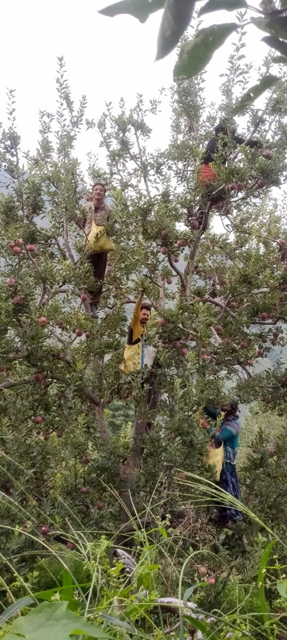 Step-1: Harvesting from giant c.50-foot-tall trees (170trees /hectare) needs climbing skills and who else but the Nepalese are called into service for harvest.
Step-1: Harvesting from giant c.50-foot-tall trees (170trees /hectare) needs climbing skills and who else but the Nepalese are called into service for harvest.
The older orchards were planted on c.100-year-old cultivar called Starking Delicious from USA.
Fun Fact: One can find this in Brogdale Collection.
Step-2: The journey of the Apple from the tree to packhouse is mostly on the back of the Nepalese, up and down steep slopes some of which can give vertigo to the faint hearted.
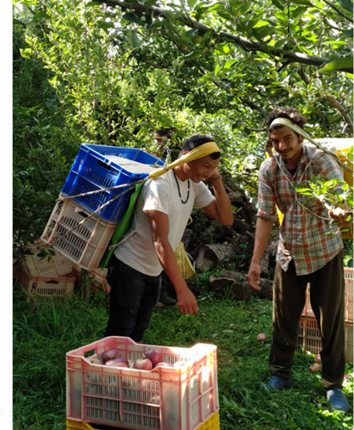
Step-3: Sorting for colour is done manually as the fruits come off simple size sorting machines. Fun fact - as opposed to British consumers, Indian consumers like large fruit 70mm+
Step 4: The packhouse. Fun Fact: The packers need to master sitting for 12 hours a day in Yogic lotus pose as they pack from 7am to well past midnight mostly.
Below: left; Step 3 and right; Step 4
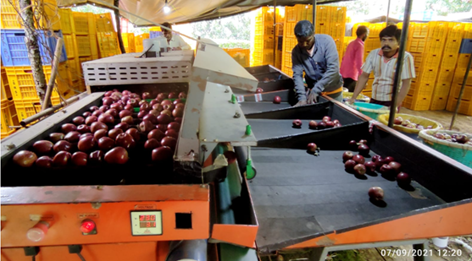
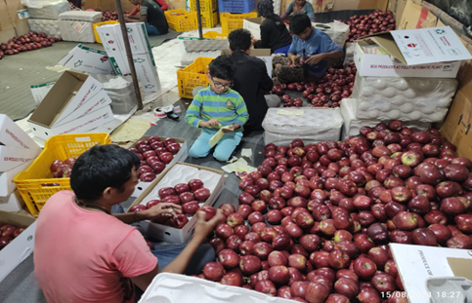
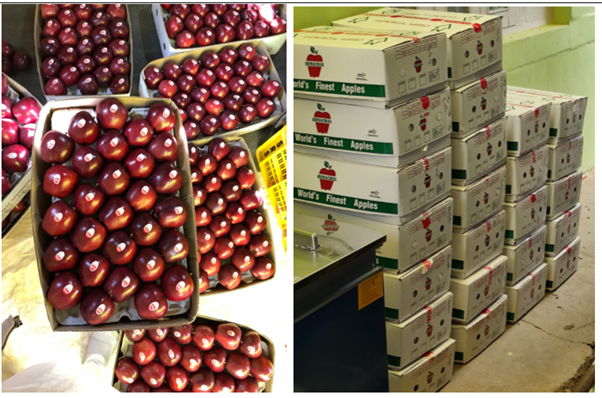 Step-5:
Step-5:
Fun fact: Green credentials. Currently, there is negligible amount of plastic/punnet packaging unlike our supermarkets.
Step-6: Well, a typical Himachal Apple endures a lot of tossing around and is then loaded on to trucks of all shapes and sizes (not refrigerated) and transported across the length and breadth of India. It is a good 2-to-6-day ride at nearly 40 degrees Celsius. Well smart fresh comes to mind.
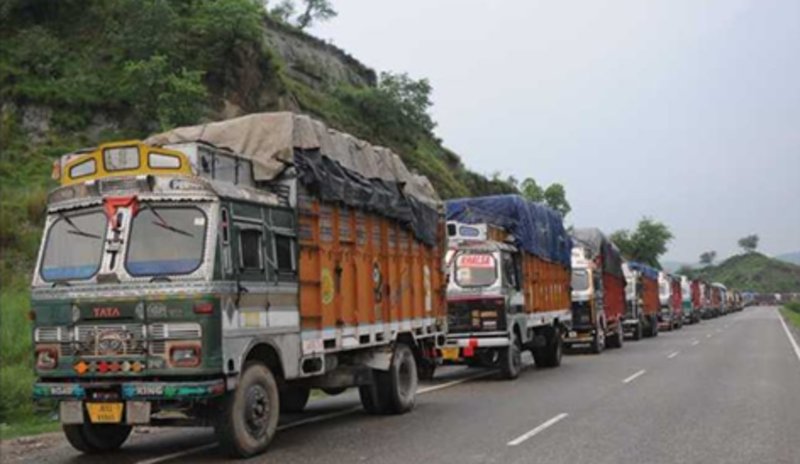
Pic-7: Apple auctions where miles yards bring together sellers and buyer hosted by agents who run auctions. Well Delhi is the Christie's of Fruit and Veg as it is largest wholesale market in Asia. Apples are the minion fruit there. Consider Bananas that come in 50+ coach trains straight into the yard and the whole train is auctioned.
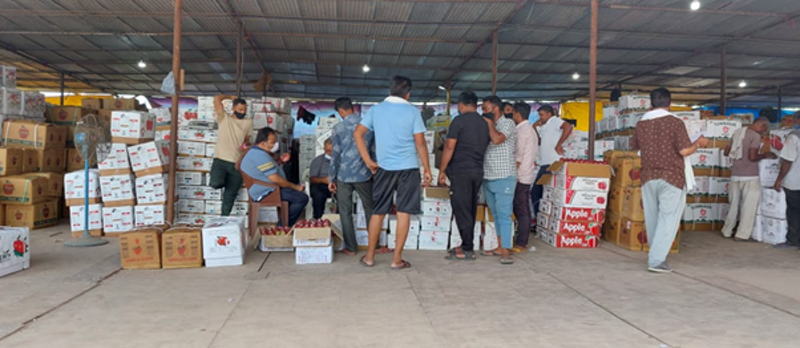
Pic-8: After passing through few layers of middlemen, the Apples reach the street hawkers, who still sell majority of the produce in addition to organised retail.
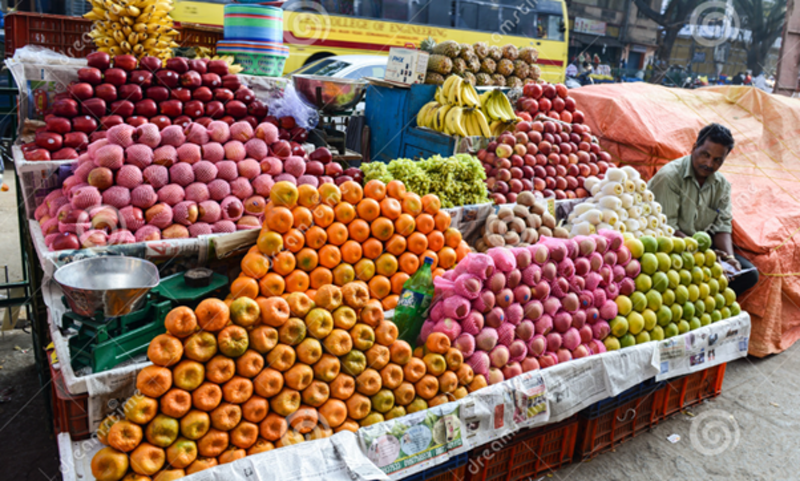
Final fun fact (cash): Despite the long chain of marketing intermediaries the net back to farmer (retail vs. net /kg to farmer) via the auction market/route is much higher than UK's/Europe's supermarket route. The large buyers are starting to flex their muscles in Indian markets as well.
This year large corporate buyers have bought Apples cheap and selling at 4x to 5x via organised retail. This has caused a lot of controversy and political debate lately.
Sounds familiar? Happy Harvest!!!
Back here in 'Blighty' everything is on the move -
Conference Pears
Over the past week, pears have fallen in pressure by around 0.8kg, starch has declined dramatically and brix
levels have improved by;0.5% in Kent and 1.5% in Wisbech. Harvesting on most sites was completed by this date last year, so we do not have comparable data. However, the data collated a week earlier on 3rd September 2020, is very comparable with this week's, providing further evidence that the season is running 7-10 days later than last year.
With pears, the Streif index is the most accurate means of determining harvest maturity. Harvesting should be
underway by the time the Streif index has fallen to 1.0 (now on early sites and in the next couple of days on all
sites) and be completed by the time it has fallen to 0.7. This is likely to be by the end of next week, although
this is obviously weather dependent.
On some farms, bird damage is now becoming a significant issue and this is leading to high levels of brown rot
(sclerotinia fructigena) in some orchards. This is another reason why harvesting should not be delayed.
Cox
Picking for long term storage should be underway or starting imminently. Over the past week average firmness
has stayed relatively static, but the starch has declined by around 15% and brix levels have improved by
The hot weather of the past few days has provided ideal conditions for ripening, so where there is adequate size
and red colour, picking should be progressing!!
Fruit destined for long term storage should have firmness >8.6kg and starch levels should be >70%.
In most cases, the pressures are still comfortably above this, but starch levels are now around the
optimum, indicating things are moving quickly.
Gala
On all sites, starch degradation has started in several apples, but many are still 100% black.
Picking should begin when the starch has started to move in all the apples and ideally, fruit picked for long term DCA storage
should be picked before the starch has declined to 80%. For long term ULO storage this should be before starch
has declined to 70%.
Typically the initial decline is very slow, before increasing rapidly to around 4%/day. This rapid decline and therefore the time at which picking should begin) is predicted to start at the end of next week and will be confirmed in next week's newsletter.
Other Varieties
Russet - picking should be end of next week (w/c 13th September)
Spartan - picking should be end of next week
Comice - picking should be middle/end of next week, but need to test to confirm or flavour will be affected.
![]() That is all for this week
That is all for this week
Take care
The English Apple Man